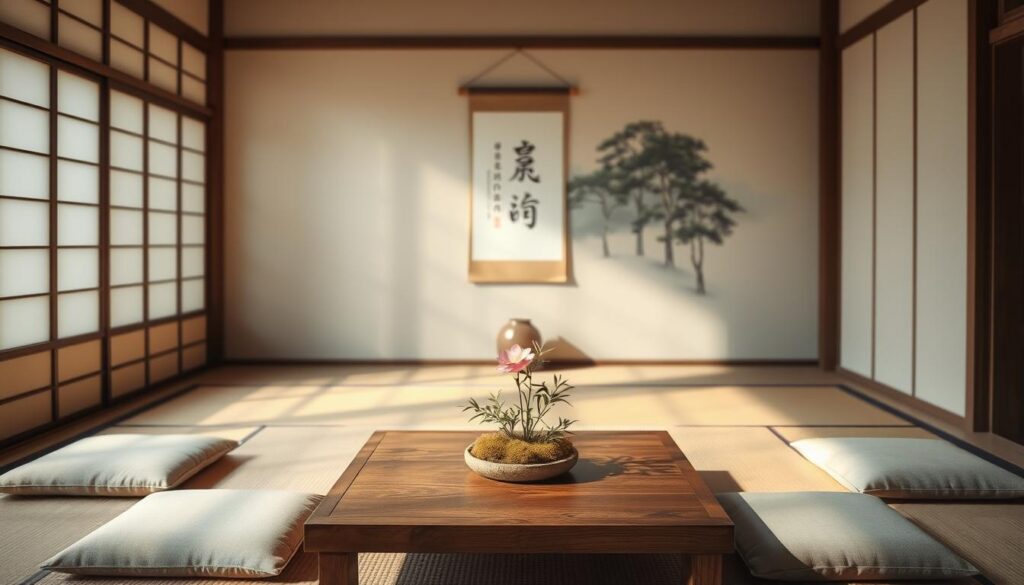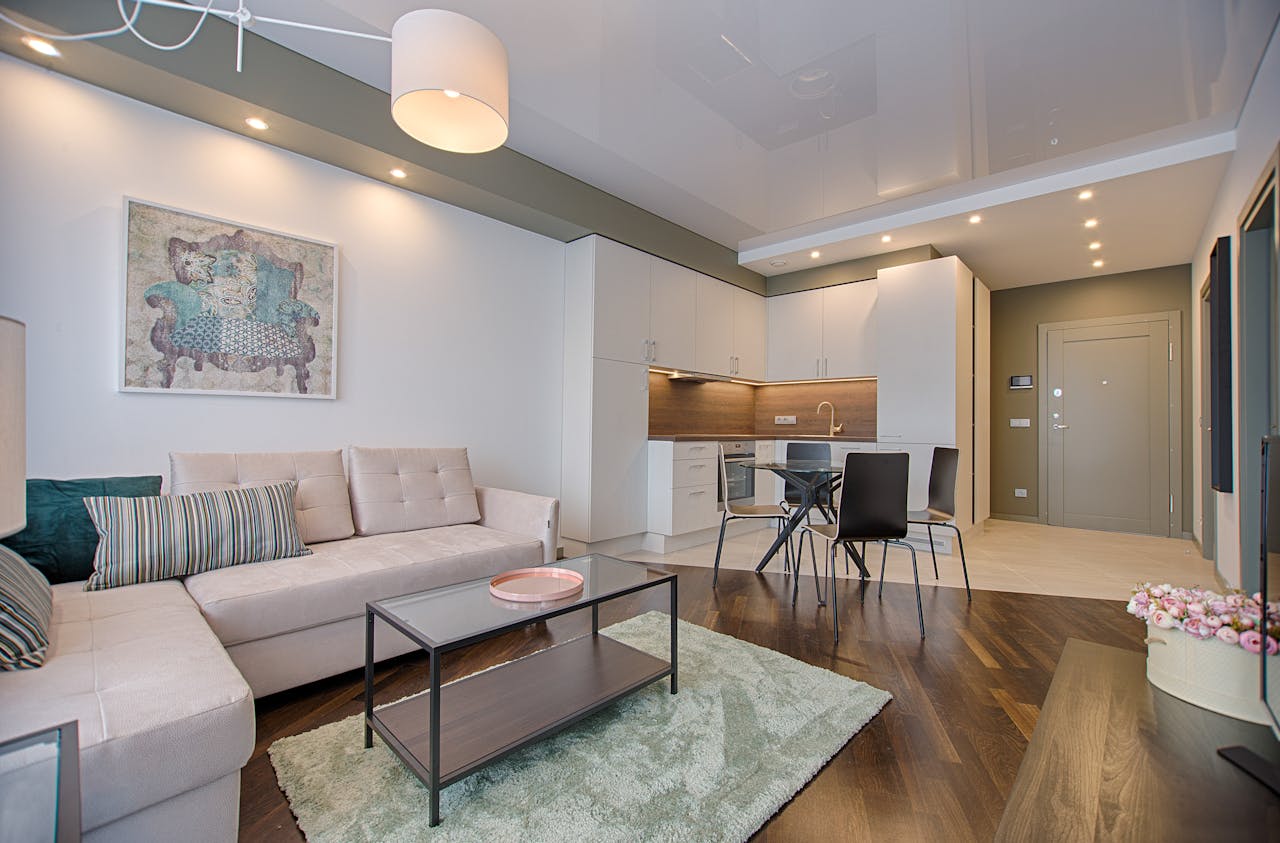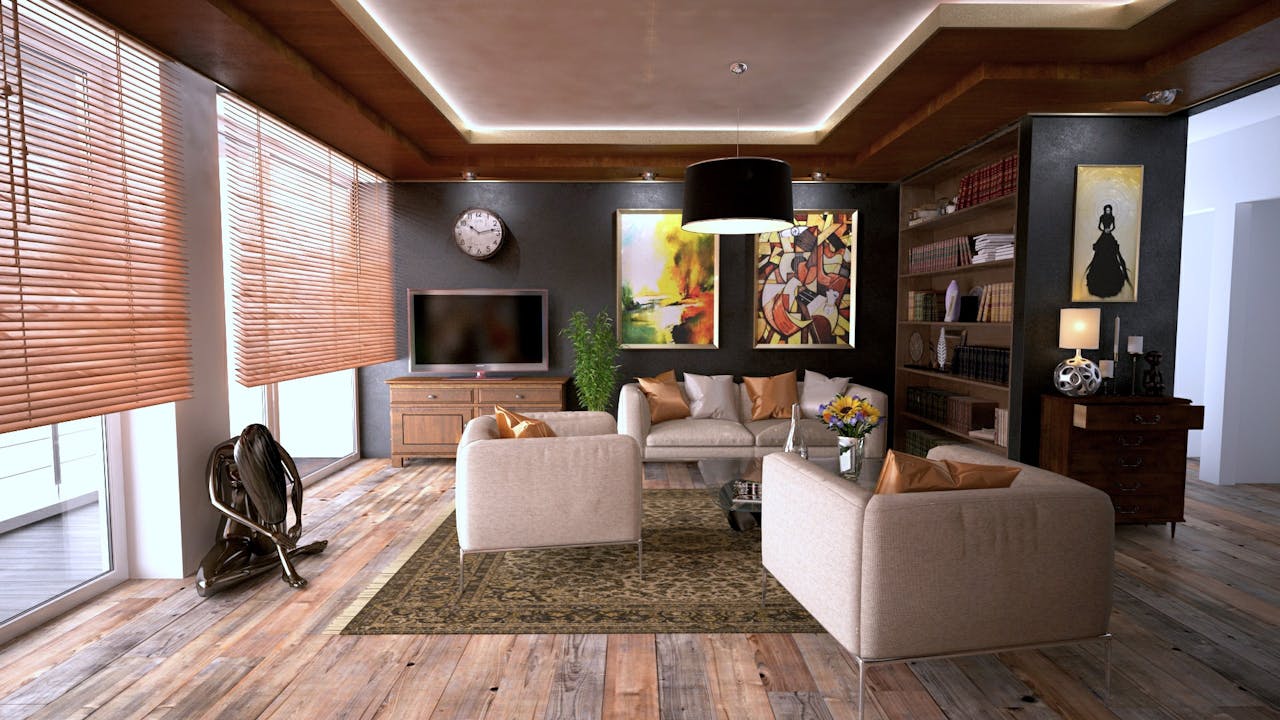Did you know that minimalist japanese decor has shaped interior design for centuries? The calm and natural beauty of japanese home interior has won hearts around the world. It brings a sense of peace and quiet.
We dive into the heart of this unique style. It’s all about simplicity, natural materials, and a deep bond with nature. At its core is Wabi Sabi, which values the beauty of flaws and change.
Key Takeaways
- Understanding the principles of traditional japanese design
- The significance of natural materials in minimalist decor
- Exploring the concept of Wabi Sabi and its influence
- Applying japanese aesthetics to modern living spaces
- Creating a serene and calming atmosphere in your home
The Essence of Japanese Home Interior Design
Japanese interior design combines simplicity with nature, making spaces peaceful. This approach honors nature and seeks tranquility, key to a zen home interior.
It focuses on minimalism and natural elements. Using natural materials in Japanese interiors like wood and bamboo, designers aim for beauty and calm.
Key Principles of Japanese Aesthetics
Japanese design values simplicity and avoids clutter. This guides the creation of Japanese-inspired living spaces, where each item adds to the space’s harmony.
- It emphasizes natural light and sliding doors to blend indoors and outdoors.
- Natural materials are used for floors, walls, and furniture.
- Plants and greenery are added to bring nature inside.
The Importance of Minimalism
Minimalism is crucial in Japanese design, aiming for a clutter-free space. This approach encourages relaxation and clarity by focusing on the essential.
| Design Element | Traditional Japanese | Modern Interpretation |
|---|---|---|
| Flooring | Tatami mats | Minimalist hardwood flooring |
| Room Dividers | Shoji screens | Sliding glass panels |
| Furniture | Low-seating, minimalist designs | Multi-functional, low-profile pieces |
Incorporating Nature in Design
Nature is essential in Japanese interior design. Elements like wood and plants are key to the look. They add texture and warmth, blending indoors with outdoors.
Adopting Japanese design principles can make our homes beautiful and peaceful. It’s about using natural materials, embracing minimalism, and bringing nature inside. Japanese design harmonizes our living spaces with the natural world.
Popular Japanese Architectural Styles
Japanese homes are known for their architectural styles. They mix old traditions with new functions. This mix makes spaces calm yet useful.
Traditional Styles: Tatami and Shoji
Traditional Japanese homes feature tatami rooms and shoji screens. Tatami rooms have mats made from grass or reeds. They’re perfect for tea ceremonies or relaxing.
Shoji screens are made from translucent paper over a wooden frame. They divide rooms or act as doors, letting in light while keeping things private.
“The traditional Japanese home, with its tatami rooms and shoji screens, embodies a sense of simplicity and harmony with nature.”
Modern Interpretations in Urban Settings
In cities, old and new designs meet. Modern apartments might have tatami room design touches. This brings calm to busy areas.
Modern Japanese design loves simplicity and natural materials. It uses lots of light and wood or paper partitions. These features make spaces feel open and connected.
| Traditional Element | Modern Interpretation |
|---|---|
| Tatami Rooms | Incorporation of tatami mats in modern flooring |
| Shoji Screens | Use of shoji-inspired partitions or room dividers |
| Sliding Doors | Modern sliding doors made from various materials |
The evolution of Japanese architecture blends old and new. This creates homes that are culturally rich and fit today’s needs.
Color Palettes in Japanese Interiors
In Japanese interior design, colors are key to creating a peaceful and welcoming space. The focus is on simplicity and blending with nature. This is seen in the use of earthy tones and natural materials.
Earthy Tones that Promote Tranquility
Japanese interiors often stick to neutral colors with earthy tones for calmness. Shades of beige, brown, and taupe remind us of soil and wood. These colors make spaces feel calm and relaxing.
Benefits of Earthy Tones:
- Creates a sense of calmness
- Promotes harmony with nature
- Enhances the feeling of serenity in a room
Utilizing Natural Light with Color
Natural light is crucial in Japanese interior design. It makes the colors pop, making the space feel more vibrant and peaceful.
| Color | Effect | Natural Element |
|---|---|---|
| Beige | Calming | Sand |
| Brown | Warmth | Wood |
| Taupe | Balancing | Soil |
Choosing the right colors and using natural light, Japanese interiors find a balance between simple and elegant. This not only makes the space look good but also improves well-being.
Essential Elements of Japanese Decor
The heart of Japanese decor lies in a few key elements. These define its unique look. Traditional Japanese homes show the country’s rich culture and offer a calm, simple living space.

Futons vs. Western Beds
Futons are a big part of traditional Japanese bedrooms. They are versatile and space-saving, making rooms more flexible. Unlike Western beds, futons sit on the floor, often on a tatami mat.
This setup follows Japanese decor’s minimalist rules. It also brings people closer to the floor, adding to the simplicity.
Choosing between futons and Western beds depends on what you like and your home’s look. But, using a futon can help you follow traditional Japanese design principles.
The Role of Sliding Doors
Sliding doors, or “fusuma,” are key in traditional Japanese homes. They divide rooms and make spaces flexible. Made from wood or paper, these doors add beauty and depth to a room.
In modern homes, sliding doors can still be used in a similar way. They help divide spaces while keeping things open, showing the spirit of traditional Japanese design.
Choosing the Right Materials
Japanese interior design focuses on natural materials for a harmonious look. These elements add beauty and calm, connecting us to nature.
Organic Materials: Wood and Bamboo
Wood and bamboo are key in Japanese design. Wood warms spaces with flooring, ceilings, and furniture. Bamboo, strong and flexible, decorates and furnishes homes. Both are prized for their natural beauty and eco-friendliness.
These materials make Japanese homes peaceful. Their textures and colors enrich the space’s look.
The Use of Stone and Paper
Stone and paper are also vital in Japanese design. Stone adds solidity in gardens and indoors. Paper, like shoji screens, softens light, creating a warm glow.
These materials follow the minimalist principle, enhancing the natural feel of the space. They help achieve the balance and harmony of Japanese interiors.
Choosing these natural materials helps us create a Japanese-inspired space. It becomes both stunning and peaceful.
Furnishings that Define Japanese Interiors
Low-profile furniture is key in Japanese interiors, making spaces feel open. This design choice reflects Japanese culture’s love for simplicity and minimalism.
Japanese furniture stands out for its low design. This is seen in low tables and seats, which help create a calm and intimate atmosphere.
Low Furniture: Tables and Seating
Low tables, often wood, are common in Japanese homes. They’re used for dining, working, or socializing, promoting a relaxed feel.
Seating in Japanese homes includes floor cushions and low stools. These match the low tables, encouraging people to sit close together. This setup fosters a sense of community and togetherness.

Built-In Storage Solutions
Built-in storage is a big part of Japanese interiors. It helps keep things tidy, bringing peace to the home.
Sliding doors and storage units are common. They keep things organized and out of sight. This design not only looks good but also encourages a clutter-free life.
| Type of Storage | Benefits | Design Features |
|---|---|---|
| Sliding Doors | Space-saving, easy access | Often made from wood or paper, designed to slide along tracks |
| Compartmentalized Units | Organized storage, clutter-free | Typically feature multiple small compartments for various items |
Japanese interiors blend low-profile furniture and built-in storage. This creates spaces that are both beautiful and peaceful.
Incorporating Art and Decor
Adding art and decor is key to a zen home interior. It shows the beauty of Japanese style. Traditional Japanese art makes homes feel calm and welcoming.
Art like calligraphy and pottery is important in Japanese homes. They make the space look good and share cultural history.
Calligraphy and Pottery in Japanese Homes
Calligraphy and pottery are loved in Japan. They help make homes calm and connect to nature. Their designs and materials add to the asian home decor, making it peaceful.
In Japanese homes, you might see calligraphy on walls or pottery on shelves. These add elegance and calm. They help make the home relaxing and welcoming.
The Influence of Zen Gardens
Zen gardens are big in Japanese decor. They use simple beauty and mindfulness. These ideas are used in home design, making spaces calm and lovely.
Adding Zen garden elements, like natural stone or plants, brings the outdoors in. It makes the home look better and feel more peaceful.
Creating a Zen-inspired Space
Creating a Zen-inspired space is more than just looks. It’s about making a place that brings calm and peace into our lives. By using minimalist Japanese decor, we can turn our homes into peaceful places that help us relax and feel better.
Techniques for Achieving Calmness
To make your space calm, try these techniques:
- Use natural materials like wood and bamboo for a cozy feel.
- Add plants like bonsai trees or ferns for clean air and calm vibes.
- Choose soft lighting to make the atmosphere calm, avoiding harsh lights.
Color also plays a big role in your space’s feel. Go for soft, muted colors like beige, gray, or pale green. These colors are key in Zen home interior design.
| Technique | Description | Benefit |
|---|---|---|
| Natural Materials | Using wood, bamboo, and stone | Creates warmth and connection to nature |
| Soft Lighting | Employing dimmable or soft light sources | Reduces eye strain and promotes relaxation |
| Minimal Color Palette | Selecting muted, natural tones | Enhances calmness and reduces visual clutter |
The Art of Decluttering
Decluttering is key to a Zen-inspired space. Getting rid of things we don’t need helps us focus and feel clear. Begin by sorting items into keep, donate, and throw away piles.
Think about Japanese home interior design as you declutter. It’s all about simplicity and the beauty of empty space. Following these ideas can make your home a more peaceful place.
Indoor Plants and Natural Elements
Nature plays a big role in Japanese interior design. It uses indoor plants and natural elements. This makes spaces look better and feel calm.
Indoor plants are key in Japanese homes. They connect the indoors with the outdoors. They bring peace and well-being, fitting Japanese design principles.
Popular Plants in Japanese Homes
Some plants are loved in Japanese design for their looks and meanings. Here are a few:
- Bamboo Palm: It’s elegant and cleans the air.
- Shiso: A green herb used in Japanese food.
- Bonsai Trees: They stand for balance and are often used as decorations.
Importance of Greenery in Design
Greenery in Japanese interiors is more than just for looks. It shows a deep love for nature. It makes spaces calm, lowers stress, and connects us to nature.
“The art of bringing nature indoors is a defining characteristic of Japanese design, reflecting a deep respect for the natural world.”
Adding indoor plants and natural elements makes a space look good and feel relaxing. It’s a way to bring Japanese style into your home.
Tips for Adopting Japanese Aesthetics in Your Home
Bringing Japanese home design into your space can make it calm and beautiful. Use natural materials, keep things simple, and go for minimalist decor. This way, you’ll create a peaceful area that encourages relaxation.
Simple Changes for Instant Impact
Begin with small changes like adding plants or using washi paper. Low-seating furniture also adds to the Japanese vibe. For more ideas, check out BHG’s Japanese Interior Design page.
DIY Projects to Embrace the Style
Try DIY projects like making a tokonoma alcove or using shou sugi ban on wood. These projects let you make your space unique while following Japanese design principles.



